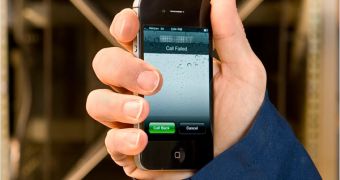The tests carried out by Consumer Reports in 2010, showing what the organization said was a design flaw in the GSM (AT&T) iPhone 4, have been made on the CDMA version of the handset, which runs on Verizon’s network. The results were pretty much identical, the reviewers said.
As it did last year, without hesitation Consumer Reports states that “The Verizon iPhone 4 has a problem that could cause the phone to drop calls, or be unable to place calls, in weak signal conditions,” after its engineers put it to the test in a special lab.
Despite the fact that iPhone 4 is Consumer Reports’ highest-rated handset, Apple’s smartphone is allegedly the only one which experiences a “meaningful decline” in performance when fingers make contact with the external antenna.
Consumer Reports says that the problem is similar to the one they confirmed in July with the AT&T GSM version of Apple's phone.
“It can occur when you hold either version of the phone in a specific but quite natural way in which a gap in the phone's external casing is covered,” it explains.
The testers admit that “The phone performs superbly in most other respects,” and note that “using the iPhone 4 with a case can alleviate the problem.”
They also admit that “there has been no […] outpouring of complaints about the Verizon version of the phone,” and that “no calls were dropped” during the tests, yet Consumer Reports shows a photo of the Verizon iPhone 4 with a ‘failed’ call on-screen (image above).
Apparently, the ‘death grip’ applies to the CDMA iPhone 4 as well, despite the fact that Apple commanded a redesign of its antenna to make it compatible with Verizon’s wireless network.
When the iPhone 4 was originally launched on AT&T’s network in the summer of 2010, Apple was faced with a PR nightmare related to the phone’s inability to hold a strong signal in some conditions.
Apple declined to admit there was an actual problem with reception, and released a software update tasked with adjusting the number of signal lines displaying on the handset’s screen.
It is still unknown who or what was mostly to blame for the iPhone 4 ‘antennagate’ - AT&T’s strained network, or the actual design of the Apple device.

 14 DAY TRIAL //
14 DAY TRIAL //